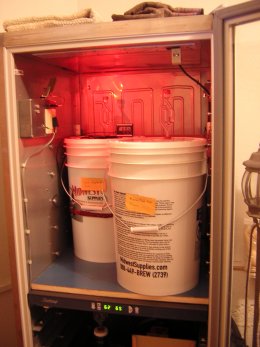Joerg
2017-03-21 20:42:47 UTC
After brewing my 2nd Belgian Tripel a week ago I had an even "louder"
kraeusen blow-off than during my 1st. BE-256 yeast going nuclear. This
time I had a 3/8" blow-off hose into a 1-gal milk jug half-filled with
StarSan solution. It still lifted the otherwise hard-to-pry lid of the
bucket, opposite the side where the blow-off tapped in. Wild burping in
the middle of the night along with evil hissing and liquid oozing down
the sides of the fermenter. Of course, I had learned my lesson and
placed it on a tiled surface in an area where even a grenading lid would
not trigger a major remodeling effort.
A brewpub owner recommended FermCap:
http://www.northernbrewer.com/fermcap-s-1-oz
Questions:
1. Will this make the trub unsafe for consumption? Aside from harvesting
yeast we use all of the remaining trub to make bread. So the FermCap
drops will be in there.
2. What is the shelf life of this stuff? I would only need it on
high-alcohol Belgian brews.
Two days later I dared to move it into the fermentation chamber:
Loading Image...
Behind it is a Superior Strong Ale in primary. Brewed same day, regular
US-05 yeast, no Belgian candi sugar, very behaved in fermentation. In
the chamber below are two secondary fermenters with Pale Ale and IPA and
the heater module in front. It is a former wine fridge modified to be
able to heat and cool, with the bottom half being colder for secondary
fermentation and resting.
kraeusen blow-off than during my 1st. BE-256 yeast going nuclear. This
time I had a 3/8" blow-off hose into a 1-gal milk jug half-filled with
StarSan solution. It still lifted the otherwise hard-to-pry lid of the
bucket, opposite the side where the blow-off tapped in. Wild burping in
the middle of the night along with evil hissing and liquid oozing down
the sides of the fermenter. Of course, I had learned my lesson and
placed it on a tiled surface in an area where even a grenading lid would
not trigger a major remodeling effort.
A brewpub owner recommended FermCap:
http://www.northernbrewer.com/fermcap-s-1-oz
Questions:
1. Will this make the trub unsafe for consumption? Aside from harvesting
yeast we use all of the remaining trub to make bread. So the FermCap
drops will be in there.
2. What is the shelf life of this stuff? I would only need it on
high-alcohol Belgian brews.
Two days later I dared to move it into the fermentation chamber:
Loading Image...
Behind it is a Superior Strong Ale in primary. Brewed same day, regular
US-05 yeast, no Belgian candi sugar, very behaved in fermentation. In
the chamber below are two secondary fermenters with Pale Ale and IPA and
the heater module in front. It is a former wine fridge modified to be
able to heat and cool, with the bottom half being colder for secondary
fermentation and resting.
--
Regards, Joerg
http://www.analogconsultants.com/
Regards, Joerg
http://www.analogconsultants.com/